Owen Paterson: Ash dieback will not be eradicated
- Published
Environment Secretary Owen Paterson: "The scientific advice is that it won't be possible to eradicate this disease"
Environment Secretary Owen Paterson has acknowledged that ash dieback, a disease that threatens the UK's ash trees, will not be eradicated.
Announcing the government's action plan to tackle the disease, external, Mr Paterson said efforts would focus on slowing its spread through the countryside.
Diseased young trees would be removed and destroyed, he added.
But the action plan stated that there were no plans to remove mature trees, which are important for wildlife.
It added that efforts would also focus on developing resistance to the disease.
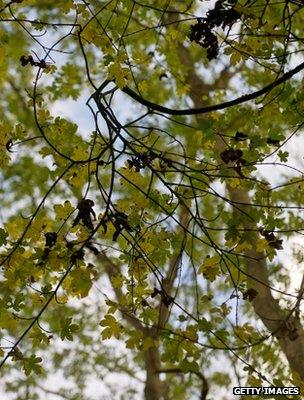
Mature ash trees will not be removed from the landscape, the government's action plan says
Conservation groups welcomed the government's assurance that no diseased mature tree would be cut down.
"The scientific advice is that it won't be possible to eradicate this disease now that we have discovered it in mature trees in Great Britain," Mr Paterson said.
"However, that does not necessarily mean the end of the British ash.
"If we can slow its spread and minimise its impact, we will gain time to find those trees with genetic resistance to the disease and to restructure our woodlands to make them more resilient."
He told reporters that the arrival of ash dieback meant his department would have to reconsider its priorities.
"If we are going to really do something radical on the way we handle our forestry in the future and change the priorities, we are going to have to shift resources within Defra.
"There will be some things we do in Defra now that we are going to have to stop doing."
Speaking at a briefing, Defra chief scientific adviser Prof Ian Boyd said: "By next season, we could potentially have resistant forms of ash growing in this country.
"We need to put in scientific research to try and get genetic markers for resistance so that we can go out into our current woodlands that have not been infected and identify trees that might survive relative to those who might not survive."
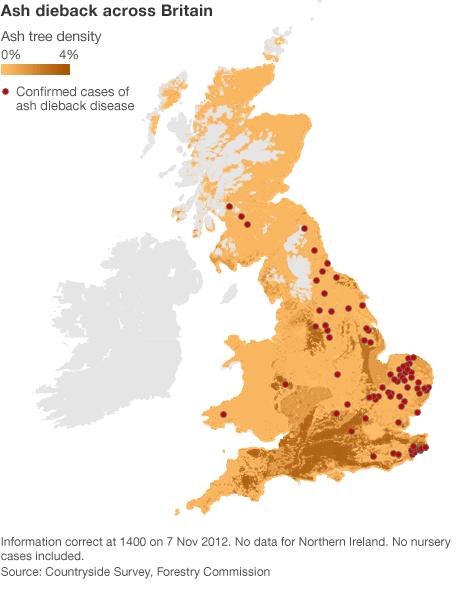
Survey results on Wednesday confirmed that the disease was present at 115 sites in England, Wales and Scotland, external.
The action plan outlined a number of areas where government efforts would be focused. These included:
reduction of the rate of spread of the disease,
development of resistance to the disease in the native UK ash tree population,
encourage the public and landowners to help monitor trees for signs of ash dieback.
It explained that newly-planted diseased trees and diseased trees in nurseries would be traced and destroyed because once young trees become infected, they succumb to the pathogen.
However, there was no intention to fell mature trees because as well as being important to wildlife, they take longer to die and could provide vital clues for scientists looking for genetic strains that might be resistant to the disease.
The latest data showed that infection, caused by the fungus Chalara fraxinea, did not occur directly from tree to tree, only via leaf litter.
Over the coming weeks, the government said it would work with scientists and other "interested groups to further develop and implement the measures in the plan, and to set a longer term approach to tackling Chalara".
Aerial assault
A ban on ash imports and the movement of trees from areas with confirmed cases of dieback came into force on 29 October, just days after government scientists confirmed that the disease had reached the UK's natural environment - at sites in East Anglia.
Dieback, caused by the Chalara fraxinea fungus, was first recorded in eastern Europe in 1992 and spread over two decades to infect most of the continent.
The first confirmed cases in UK woodlands were at sites in Norfolk and Suffolk. Scientists said the infections were most likely to have been the result of spores from the fungus being blown across from mainland Europe.
Prof Boyd explained that computer modelling showed that there were days when meteorological conditions existed that would have seen a "plume of spores across the UK".
RSPB conservation director Martin Harper welcomed the publication of the government's action plan, saying it was a "vital part of stopping the spread of this disease".
"Upland ash woodland and ash in the UK's lowland woods and hedges are important habitats for a wide range of plants and animals," he said.
"We are pleased that protecting this wildlife has been enshrined in the Government's approach to tackling ash dieback."
But he added that the arrival of Chalara Fraxinea in the UK should act as a "wake-up call".
"It is essential that we change the way we move animals and plants around the country and across international borders," he warned.
"Regulation must be put in place to ensure this does not happen again - our natural environment is too precious."
Woodland Trust chief executive Sue Holden echoed the RSPB's "wake-up call" warning, but added that she supported the view that no mature ash trees should be felled.
"This underlines widespread concerns that rapid and ill-considered action in our mature and ancient woods could do more harm than good," she said.
"We do not want to remove small populations of resistant ash that may hold the key to the survival of the species across the country."
The most visible sign that a tree is infected with Chalara ash dieback is bleeding sores and cankers on the bark, and discolouration of the underlying sapwood.
The sores often surround branches in the infected area of the tree, causing the dieback of shoots, twigs, branches and smaller stems.
The disease has also been shown to infect ash tree leaves, appearing as blemishes.
There are numerous other diseases that display similar symptoms, making it difficult to identify for most people.
The Forestry Commission has issued guidance, external on how to identify the disease.
How ash dieback could threaten Britain's wildlife
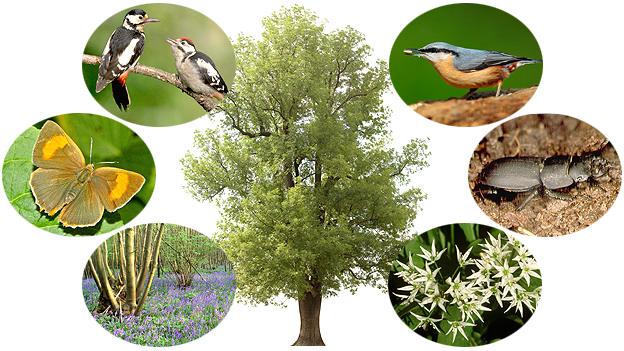
Britain's population of 80 million ash trees provides shelter and food for a wide range of wildlife, mostly birds and insects. The species' loosely-branched structure means plenty of light reaches the woodland floor, allowing a variety of plants to grow beneath them.
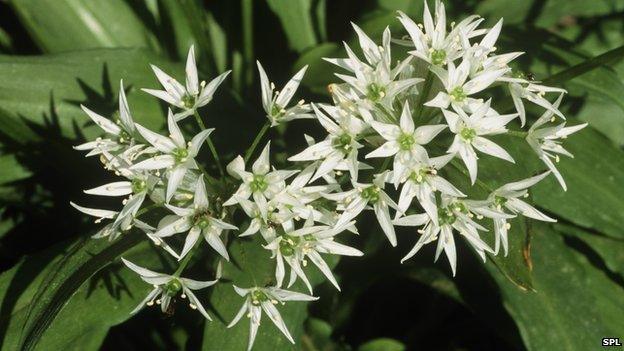
Wild garlic (ramsons) is among the plants that thrives beneath the ash tree. Others include dog's mercury, wood cranesbill, wood avens and hazel. Because ash bark is alkaline, the trees also support a wide range of lichens and mosses and attract snails.

Carpets of bluebells are often seen under and around ash trees. Norfolk’s Lower Wood, in Ashwellthorpe, famous for its spring display of bluebells, is among those areas where ash dieback disease has been discovered.
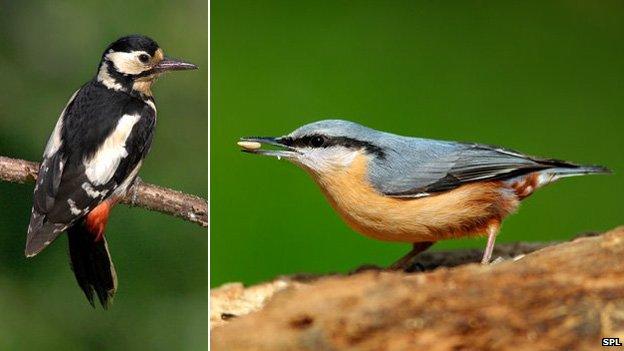
A rich ground layer beneath the ash means plenty of food for birds such as warblers, flycatchers and redstarts. Hole-nesting birds, such as owls, woodpeckers and the nuthatch, are also frequent visitors.

More than 100 species of insect are also known to live on ash. At least 60 of the rarest have an association with the tree – mostly beetles and flies. Because ash is very long-lived, it can also support specialist deadwood species, like the lesser stag beetle.
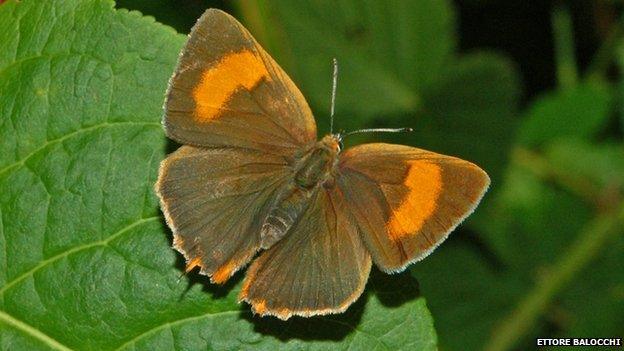
The brown hairstreak butterfly, the largest of the UK hairstreaks, is also a frequent user of the ash. They congregate high in the trees for breeding. Ash also supports a wide variety of moths. Source: The Wildlife Trusts